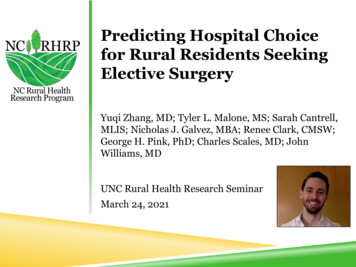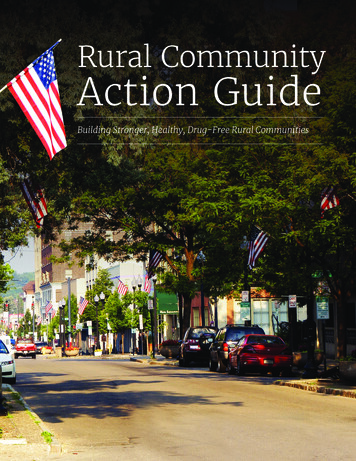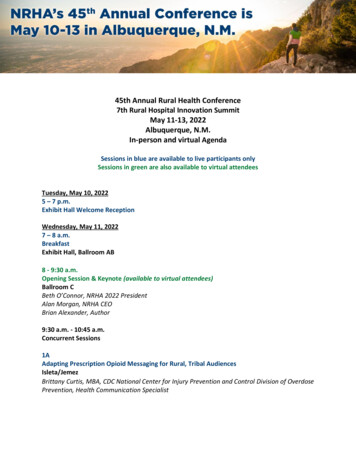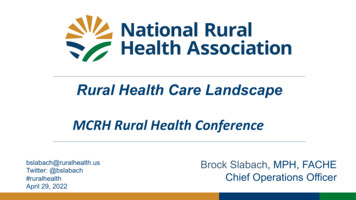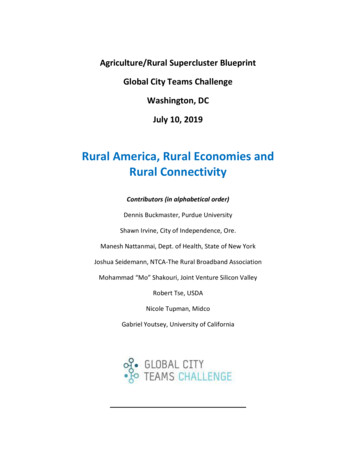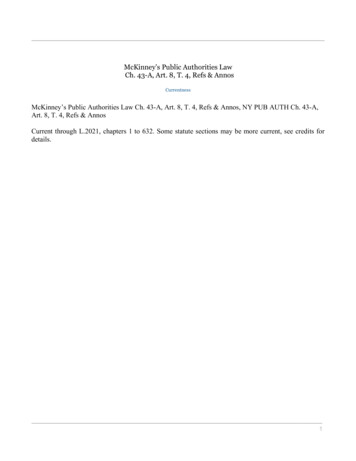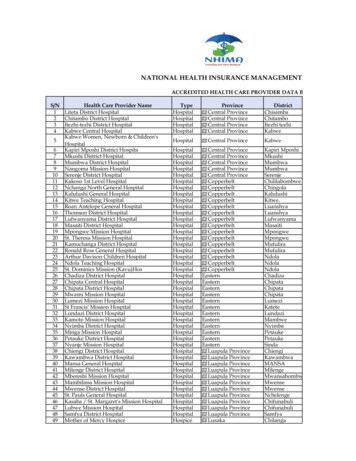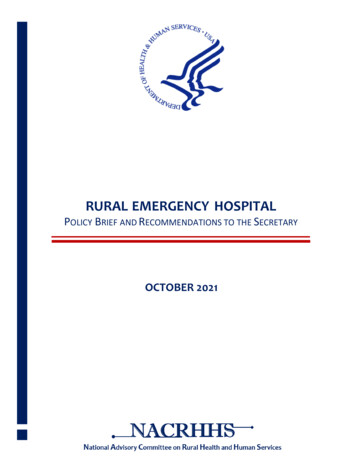
Transcription
RURAL EMERGENCY HOSPITALPOLICY BRIEF AND RECOMMENDATIONS TO THE SECRETARYOCTOBER 2021
iEDITORIAL NOTECHAIRJeff Colyer, MDOverland Park, KSMEMBERSSteve Barnett, DHA, CRNA, FACHELake Orion, MIRobert Blancato, MPAWashington, DCKari M. BruffettLawrence, KSWayne George Deschambeau, MBAGreenville, OHMolly DodgeMadison, INMeggan Grant-Nierman, DO, MBAPoncha Springs, COGeorge Mark Holmes, PhDRaleigh, NCJoseph Lupica, JDPhoenix, AZMichelle A. MillsParker, COBrian MyersSpokane, WAIn October 2021, the National Advisory Committee on RuralHealth and Human Services (hereinafter referred to as “theCommittee”) convened its 89th meeting virtually to examinetwo topics, Behavioral Health and Primary Care Integration andthe Rural Emergency Hospital (REH), a new type of rural hospitalcreated by Congress in 2020. This policy brief address the REHmodel. Prior to the meeting, the Committee heard from avariety of policy experts, academics, and communitystakeholders for their perspectives on the potentialopportunities and challenges for the REH provider designation.ACKNOWLEDGEMENTSThe Committee would like to acknowledge those whosecomments and insights helped make the October 2021 meetingand this policy brief possible.The Committee would like to thank all the following individualsfor sharing their expertise: Emily Cook, JD (McDermott Will &Emery); George Pink, PhD (University of North Carolina);Margaret Greenwood-Ericksen, MD, MPH (University of NewMexico); the Patterson Foundation; and the subject matterexperts in the Federal Office of Rural Health Policy.Kellie M. Phillips, MSN, RNHysham, MTPatricia SchouPrinceton, ILRobert L. Wergin, MD, FAAFPMilford, NEJames Werth, Jr., PhD, ABPPBristol, VALoretta WilsonBoligee, ALEXECUTIVE SECRETARYSahira Rafiullah, MPARockville, MDNational Advisory Committee on Rural Health and Human Services
iiPOLICY RECOMMENDATIONSRecommendation 1: The Committee recommends that the Secretary provide flexibility in theenforcement of the 24-hour average length of service requirement at REHs to account for unexpectedservice volume surges (flu, COVID, accidents, etc.) and the relative availability of ambulance servicetransfer to an acute care hospital.Recommendation 2: The Committee recommends that the Secretary allow for flexible staffing acrossthe various clinical parts of an REH or in any other clinical operation it offers.Recommendation 3: The Committee recommends that the Secretary ensure a flexible survey processfor REHs that allows for the use of shared space (waiting rooms, furniture, entrances, etc.) toencourage co-location.Recommendation 4: The Committee recommends that the Secretary allow for the doctor of medicine orosteopathy to be on-call, either in person or remotely (e.g., via telephone or electronic communication),to provide medical direction, consultation, and supervision for the services provided in the REH.Recommendation 5: The Committee recommends that the Secretary ensure that Medicare Conditionsof Participation allow the REH administrator to meet the requirement for a Nursing HomeAdministrator or that a licensed Nursing Home Administrator from a nearby facility can serve in thatrole.Recommendation 6: The Committee recommends that the Secretary require REHs to report on theapplicable measures specified in the CAH Medicare Beneficiary Quality Improvement Project (MBQIP)for Outpatient, Patient Safety, and Care Transitions.Recommendation 7: The Committee recommends that the Secretary work with rural stakeholders todevelop low-cost and efficient methods to appropriately measure patient experience quality of carein REHs.Recommendation 8: The Committee recommends that the Secretary ensure that calculation of theAdditional Facility Payment includes services provided in CAH swing beds as part of the actual Medicarepayments made to CAHs in 2019.Recommendation 9: The Committee recommends that the Secretary direct the Assistant Secretary forPlanning and Evaluation to study and model the appropriateness of the Additional Facility Payment tomaintain emergency and outpatient services as well as provide community benefits in the first year ofREH implementation.Recommendation 10: The Committee recommends that the Secretary include REHs as EssentialCommunity Providers at 45 CFR § 156.235 for Qualified Health Plans through the Federally-facilitatedMarketplaces.National Advisory Committee on Rural Health and Human Services
iiiRecommendation 11: The Committee recommends that the Secretary ensure that REHs have flexibility inestablishing transfer agreements that link transfer to Level I or II trauma centers to patient need whilealso allowing transfers to other hospitals as clinically indicated.Recommendation 12: The Committee recommends that the Secretary, working through the AssistantSecretary for Planning and Evaluation, assess whether REH eligibility should be expanded to meet healthcare access challenges in rural communities.Recommendation 13: The Committee recommends that the Secretary work with Congress to provideneeded technical assistance to communities considering the REH model.Recommendation 14: The Committee recommends that the Secretary expand eligibility for theNational Health Service Corps, the Nurse Corps, and the State Loan Repayment Program to REHs tohelp them address rural workforce needs and support a funding request to account for the additionaleligible entities.Recommendation 15: The Committee recommends that the Secretary work with Congress to expandeligibility for the 340B Drug Pricing Program to include REHs.Recommendation 16: The Committee recommends that the Secretary engage in a formal consultationprocess with tribal communities on possible options for adapting the REH model to serve tribalcommunities.National Advisory Committee on Rural Health and Human Services
ivPage intentionally left blankNational Advisory Committee on Rural Health and Human Services
1INTRODUCTIONIn December 2020, Congress passed the Consolidated Appropriations Act (CAA) of 20211 (Public Law 116260), which, in Section 125, created a new Medicare provider type called the Rural Emergency Hospital(REH). The REH will be a new rural hospital type that does not provide inpatient care but will provide 24hour emergency services. By creating the REH, Congress has established the first new rural provider typein over 20 years when the Critical Access Hospital (CAH) was created in 1997 under the Balanced BudgetAct (Public Law 105-33). The REH comes as a response to an ongoing period of hospital closures in ruralcommunities and to the concerns of access to emergency services in rural areas. Policymakers believe theREH will provide an option for communities that are perhaps too small to support a full-service hospital butneed more than ambulatory care. As per the legislation, a CAH or small rural hospital with no more than 50beds can convert to the REH provider type and begin providing services beginning January 1, 2023. In theintervening months, the Centers for Medicare & Medicaid Services (CMS) will create and finalizeregulations for the REH. The Committee will assess a range of questions for CMS and other policymakersto consider as it develops and finalizes the REH regulations. In keeping with the Vision, Mission, andValues2 that govern the Committee, all deliberations, insights, and recommendations presented in thispolicy brief are offered through the lens of a diverse rural America made up of communities of healthy peoplewith access to providers who offer world-class health care and human services. In particular, theCommittee notes the implications the REH program also offers an innovative way for rural communitiesto integrate care and services sectors.BACKGROUNDRural Hospital ClosuresBetween January 1, 2010, and October 1, 2021, 138 rural hospitals closed, including 93 ProspectivePayment System (PPS) hospitals and 45 CAHs. 3 i While there has been considerable attention in the mediaon rural hospital closures, a related and ongoing concern is the financial viability of the remaining facilities.During the past decade, policymakers have recognized that rural communities need options other thanfull-service hospitals, to ensure access to essential services. The CAA created the REH provider type to giverural communities with struggling rural hospitals an option between a traditional acute-care hospital andcomplete closure.The impact of rural hospital closures is varied, but is often detrimental to the communities they onceserved. When a rural hospital closes, mortality in that community increases, 4 the local economy suffers ashealth care jobs are lost, and residents must travel further to seek care. 5The University of North Carolina (UNC) Sheps Center for Health Services Research tracks rural hospitalclosures and the impact these closures have on rural communities. By their definition, a “closed hospital”is one that stopped providing short-term, general, acute inpatient care. 6 A hospital closure could beclassified as either: (1) a complete closure with no health care services available at the former hospitalsite, or (2) a converted closure that provides services other than inpatient care (e.g., outpatient,emergency, urgent care, skilled nursing, or rehabilitation services). This distinction between fully closed andconverted is important to keep in mind when thinking about what a rural hospital closure means for acommunity and why that might vary from case to case.iThis total does not include hospitals that closed and subsequently reopened.Rural Emergency Hospital NACRHHS Policy Brief October 2021
2The 138 rural hospital closures since 2010 occurred all across the United States, but many areconcentrated in the South. 7 A literature review conducted by the Rural Policy Research Institute (RUPRI)as part of research supported by the Federal Office of Rural Health Policy (FORHP) found a number offactors related to rural hospital closures, including: 8 Insufficient revenue for sustaining the cost structure of acute care hospitals; andDeclining population of the communities and other market conditions that contribute to financialinstability; andPopulations that are aged, poor, uninsured, and underinsured, leading to a high percentage ofpatient revenue from public payers (Medicare, Medicaid, etc.), who often reimburse less than thecost of providing care; andGrowing trends in health insurance and plan design that can increase bad debt and charity careburdens of hospitals, such as high deductible health plans and narrow provider networks; andShifts in health care delivery from inpatient care to outpatient care, resulting in declining inpatientutilization and associated revenue.As financial distress can be a risk factor for closure, UNC developed a financial distress index, 9 andestimated that, in 2020, 210 rural hospitals were at high risk of financial distress. 10 UNC research foundthat, overall, rural hospitals and CAHs predicted to be at high risk of financial distress served communitiesthat had a number of common factors including: Higher percentages of non-White and Black residents; andLower rates of high school graduation; andHigher rates of unemployment; andWorse health status as measured by percentage of individuals who self-report as being in fair orpoor health, obese adults, tobacco using adults, and number of premature deaths. 11Moving Toward a New ModelFor more than 30 years, members of Congress and various Administrations have worked with rural healthstakeholders to try to identify appropriate health care delivery models that are viable in ruralcommunities. Several special Medicare payment designations and demonstrations have been used tosupport rural communities. The Sole Community Hospital (SCH) designation began in 1983 to providealternative payments to hospitals that may be the sole provider in a geographic area. In the late 1980s,the Montana Medical Assistance Facility demonstration tested whether converting a full-service hospitalinto a low-intensity, short-stay health care service center could preserve basic care in rural areas. In 1990,a Medicare Dependent Hospital designation was established to increase payments to rural hospitals servinga significant portion of Medicare beneficiaries. In the 1990s, the idea of creating a limited-scope hospitalin a rural areas was expanded to seven states in the Essential Access Community Hospital and RuralPrimary Care Hospital demonstration (EACH/RPCH). 12 In 1997, Congress created CAHs in the BalancedBudget Act of 1997.From 2010 through 2013, FORHP and CMS administered the Frontier Extended Stay Clinics (FESC)demonstration primary care clinics in isolated areas to provide Medicare beneficiaries with services overextended periods, including overnight. This model was designed to address the needs of seriously ill orinjured patients who could not be transferred to a hospital, or who needed monitoring and observationfor a limited period of time. The FESC demonstration had mixed results. 13 14 It successfully showed thatsmall frontier ambulatory practices could offer extended-stay services and that patients found value inthe service such as saved time, lower transportation costs, and being able to receive care locally.15Rural Emergency Hospital NACRHHS Policy Brief October 2021
3However, low reimbursement rates coupled with low patient volume made the model not financiallyviable.The increase in rural hospital closures in recent years has created concerns among stakeholders andpolicymakers about dwindling access to essential services in rural communities. As a result, members ofCongress, advocacy groups, and others proposed plans to address these concerns and eventuallycoalesced around a new hospital type that would not provide inpatient services, but would focus onoutpatient and emergency services.In 2015, the House and Senate both introduced the “Save Rural Hospitals Act,” to establish a programwhereby rural hospitals meeting specified requirements would be eligible for enhanced payment forcertain outpatient services and called it the Community Outpatient Hospital (COH) program. The billattracted attention but did not move toward passage and its sponsors reintroduced it in each new sessionof Congress over the next five years. During that time, the Medicare Payment Advisory Committee(MedPAC), an independent congressional agency that provides analysis and policy advice on the Medicareprogram, also weighed in. In its June 2018 report, MedPAC recommended that Congress should “allowisolated rural stand-alone emergency departments (more than 35 miles from another emergencydepartment) to bill standard outpatient prospective payment system (OPPS) facility fees and provide suchemergency departments with annual payments to assist with fixed costs.”16 Finally, during the 2020Presidential election, then-candidate Joe Biden put forward a proposal that called for more flexibilities forrural hospitals that included the COH provider type put forward by the Save Rural Hospitals Act. 17 Othergroups, such as the National Rural Health Association (NRHA)18 and the American Hospital Association(AHA)19 have endorsed the Act.The Rural Emergency HospitalThe culmination of these efforts came in December 2020, when Congress passed the CAA. Section 125 ofthe CAA established the REH designation under the Medicare program, a new type of rural hospital thatwould receive enhanced payment on the condition that certain requirements are met. 20 The legislationprovides guidance as to the eligibility requirements and payment structure, but CMS will have to establishregulations through the rulemaking process prior to January 1, 2023, the statutory effective date.Hospitals wishing to become an REH must meet the statutory requirements laid out in the CAA. Theserequirements fall into the four broad categories below. 21 Eligibility: CAHs and small rural hospitals with no more than 50 beds that meet criteria set forthby the Act, as well as other requirements to be established by CMS, will be eligible to convert toan REH.Application: In order to transition to become an REH, an existing hospital must “an action plan forinitiating rural emergency hospital services, including:o A detailed action plan that lists the specific services that the facility will retain, modify,add, and discontinue; ando The outpatient services that will be offered; ando How the facility will use the additional funds it receives including telehealth services,ambulance services, operating costs, and maintaining the emergency; ando Other requirements that CMS puts in place.Requirements: An REH must:o Not provide acute care inpatient services; ando Not exceed an annual average patient length of stay of 24 hours; andRural Emergency Hospital NACRHHS Policy Brief October 2021
4 o Have a transfer agreement in place with a Level I or II trauma center; ando Maintain a staffed emergency department, including staffing 24 hours a day, seven daysa week by a physician, nurse practitioner, clinical nurse specialist, or physician assistant;ando Meet CAH-equivalent Conditions of Participation (CoPs) for emergency services; ando Meet applicable state licensing requirements; ando Meet quality reporting standards established by the HHS Secretary; ando Meet requirements applicable to skilled nursing facilities in the case where the REHincludes a distinct part unit; ando Meet other requirements that the Secretary finds necessary in the interest of the healthand safety of individuals who are furnished care at an REH.Reimbursement: Medicare payments for outpatient services will be made at the OPPS rate, plusa 5% add-on to that rate. There will also be an Additional Facility Payment (AFP) that will be afixed monthly payment. CMS will determine the amount of the AFP, however, the legislationprovides a formula for 2023 that is based on 2019 reimbursements to CAHs. Starting in 2024,REH’s fixed monthly payment amounts will be based on the 2023 payments and increased eachyear by the hospital market basket percentage increase.FEDERAL PROGRAMSThe REH provider type will have implications for many different federal entities, starting with CMS, whichis responsible for rulemaking for the REH. Below is listed the federal entities for which the REH will haveimplications.CMSSection 125 of the CAA charges CMS with finalizing the regulations to create the REH provider type. CMSis also responsible for setting Medicare payment rates, establishing CoPs, surveying the facilities, andmonitoring ongoing compliance. In advance of rulemaking, CMS has issued a Request for Information onthe REH to solicit comments from stakeholders. Additionally, CMS held an All Tribes webinar in Octoberof this year, seeking input on the potential implications of the REH for the Indian Health Service (IHS) andTribal Hospitals.Health Resources and Services Administration (HRSA)The FORHP is located in HRSA and is charged in Section 711 of the Social Security Act (SSA) with advisingthe HHS Secretary on rural health issues. In addition, FORHP administers the grants specified underSection 1820(g) of the SSA to support CAHs under the Medicare Rural Hospital Flexibility (Flex) Program,and hospitals with fewer than 50 beds under the Small Hospital Improvement Program (SHIP). These grantprograms are administered in partnership with the states and focus heavily on technical assistance. TheFlex Program’s goals are to support CAHs to enhance the quality of rural health care, improve financialand operational performance, integrate with rural Emergency Medical Services (EMS) agencies, enhancerural communities through population health improvement, and develop innovative models of care. Thestatutory REH language does not mention the administration of technical assistance. However, givenFORHP’s statutory charge, it is reasonable to expect that the office will have the experience and interestin the implementation of the REH and its ongoing impact on rural communities.Rural Emergency Hospital NACRHHS Policy Brief October 2021
5REHs also could potentially participate in programs operated under HRSA’s Office for the Advancement ofTelehealth. The statutory language allows REHs to be telehealth originating sites, meaning that they canserve as locations where patients physically go to access telehealth. The new REHs also may benefit fromHRSA’s workforce programs, particularly the National Health Service Corps, Nurse Corps RepaymentProgram, and State Loan Repayment Program. These programs provide loan repayment and other supportfor clinicians willing to practice in underserved areas.Other HHS EntitiesOther HHS entities will also likely be involved with the REH before or after it becomes a provider type.Those entities are listed below: The Indian Health Service: The mission of the IHS is to “to raise the physical, mental, social, andspiritual health of American Indians and Alaska Natives to the highest level.”22 Some tribalhospitals could be candidates to convert to an REH, which means that the REH model hasimplications for the IHS mission.The Substance Abuse and Mental Health Services Administration: REHs may also be of interest toother HHS programs meant to support mental health and substance abuse, which are primarilyoperated by the Substance Abuse and Mental Health Services Administration (SAMHSA). WhileREHs are bound by legislation to only provide outpatient and emergency services, this may includeambulatory behavioral health services, including substance use disorder treatment.The Administration for Children and Families and the Administration for Community Living: REHscan also play a role in addressing social determinants of health, which often have a substantialimpact on rural communities. REHs could be eligible for programs operated by other HHS entitieslike the Administration for Children and Families and the Administration for Community Living.The Centers for Disease Control and Prevention (CDC) could potentially engage REHs for publichealth and infection control initiatives in the future.Other Federal EntitiesREHs will be operating in rural areas, meaning that they could potentially interact with other federalprograms that address economic, agricultural, nutritional, educational, and technological issues. Entitiesthat work on these issues include the Department of Labor and its Employment Training Administration,the Department of Agriculture, and the Federal Communications Commission. These entities may beinterested in supporting REHs as a new provider type in improving access to care, and REHs may find theseentities useful in their efforts to improve health care.POLICY RECOMMENDATIONSThe Committee is encouraged that CMS issued a Request for Information in its proposed Calendar Year2022 Medicare Outpatient Prospective Payment System Rule. 23 This policy brief seeks to add to that publicsubmission and offer a range of recommendations and considerations for the Secretary when finalizingthe REH regulations. For the purposes of this brief, the Committee initially focused on key issues relatedto potential CoPs, quality reporting requirements, the structure and design of the REH payments,emergency medical transfer, and other HHS-actionable policy issues. The brief alsoRural Emergency Hospital NACRHHS Policy Brief October 2021
6includes an examination of issues that go beyond that which was specified in the legislation that HHS maywant to consider in future budget and policymaking activities.Conditions of ParticipationThe Committee believes CMS should provide as much regulatory flexibility as possible in the CoPs, takinginto account the size and scale of the REH. While the CAH CoPs may be informative, it is clear that the REHwill be a different and more limited clinical operation. For example, the Committee believes CMS shouldexercise caution in setting any sort of formal guidance related to patient acuity levels that would trigger atransfer to a high-level facility to provide flexibility and to recognize the diversity of situations for eachREH. It also will be important to flexibly define the requirements related to 24-hour observation periodfor REHs and the "reasonable expectation" on that time period. The Committee's concern is that theambulance services needed to transfer a patient may not be available in a timely manner.CMS also may want to review key lessons learned from the FESC demonstration, which has some basicsimilarities to the REH. 24 25 In that demonstration, challenges arose, such as storage of blood products andthe quantity of those products that had to be maintained. It may be that the correct CoP balance for theREH is somewhere between the CAH and FESC standards.Recommendation 1: The Committee recommends that the Secretary provide flexibility in theenforcement of the 24-hour average length of service requirement at REHs to account for unexpectedservice volume surges (flu, COVID, accidents, etc.) and the relative availability of ambulance servicetransfer to an acute care hospital.Co-located services/Provider-based entitiesHistorically, the Committee has supported efforts to promote co-location of services in rural communities.With the establishment of the REH, HHS has an opportunity to promote this notion as REH converters maybe in hospitals that have available space to lease to other services. This could include RHCs, skilled nursingfacilities (SNFs) as distinct-part units of the REH, or dialysis clinics. The challenge for CMS will be to accountfor the small scale and size of the REH and to take that into account in a way that reduces administrativeburden in the initial and ongoing survey and oversight processes.Recommendation 2: The Committee recommends that the Secretary allow for flexible staffing acrossthe various clinical parts of an REH or in any other clinical operation it offers.Recommendation 3: The Committee recommends that the Secretary ensure a flexible survey processfor REHs that allows for the use of shared space (waiting rooms, furniture, entrances, etc.) encourageco-location.StaffingThe Committee also notes a number of CoP staffing considerations. The statutory language is clear thatthe CoPs for CAH emergency services (42 CFR § 485.618) apply to REHs. However, during the COVID-19Public Health Emergency (PHE), CMS waived the requirement for CAHs that a doctor of medicine orosteopathy be physically present to provide medical direction, consultation, and supervision for theservices provided in the CAH at 42 CFR § 485.631(b)(2). 26 CMS explains their reasoning for this waiver isRural Emergency Hospital NACRHHS Policy Brief October 2021
7that “this will allow the physician to perform responsibilities remotely, as appropriate. This also allowsCAHs to use nurse practitioners and physician assistants to the fullest extent possible, while ensuringnecessary consultation and support as needed.”27 The Committee believes REHs will need even morestaffing flexibility than CAHs, given their smaller size and staffing. The waivers given to CAHs during thePHE represent a model that they could use for REHs under normal, non-PHE, circumstances. In providingthis flexibility, the Committee recognizes that REHs would need to meet all applicable state staffing,educational training, and scope of practice requirements.Recommendation 4: The Committee recommends that the Secretary allow for the doctor of medicine orosteopathy to be on-call, either in person or remotely (e.g., via telephone or electronic communication),to provide medical direction, consultation, and supervision for the services provided in the REH.It is likely that some of the hospitals that convert to REHs will have previously offered skilled nursing careservices through Swing Beds. As they transition to REH status, these facilities may still need to offer theseservices. While the legislation made no allowance for swing beds in the traditional sense, it did allow foran REH to have an associated Skilled Nursing Facility (SNF) distinct-part unit. However, Medicare SNF CoPsrequire a certified licensed nursing home administrator. This requirement may pose an extra burden onthe REH.Recommendation 5: The Committee recommends that the Secretary ensure that Medicare Conditionsof Participation allow the REH administrator to meet the requirement for a Nursing HomeAdministrator or that a licensed Nursing Home Administrator from a nearby facility can serve in thatrole.Quality ReportingThe REH authorizing language includes a considerable amount of flexibility and discretion for the HHSSecretary in requirements for reporting on quality, and it acknowledges the challenges of qualitymeasurement when there are low patient volumes. The Committee believes that CMS would benefit frombuilding on the success of the CAH Medicare Beneficiary Quality Improvement Project (MBQIP)28 and aswell as the lessons learned from the CMS-sponsored National Quality Forum (NQF)29 rural qualitymeasurement reports. For example, the NQF work to inform the Measure Applications Partnership (MAP)Rural Health Final Report of 201830 identified a core set of rural-relevant measures that included measuresrelated to emergency care. NQF’s work is ongoing.MBQIPThe MBQIP was designed by HRSA to promote voluntary quality reporting by CAHs. Under current statute,all PPS hospitals are required to submit quality data to receive their full Medicare payment update. CAHs,which are not paid using the PPS, do not have the same quality reporting requirements. HRSA, throughFORHP, used funding from the Flex program to support voluntary CAH quality reporting. The MBQIPidentified a set of existing quality measures that were the most relevant for CAHs, given their size andscale, and worked with those facilities to support quality reporting. The MBQIP currently includesmeasures in four areas: Patient Safety/Inpatient, Patient Engagement, Care Transitions, and Outpatient.Of these four areas, the Committee believes that three are relevant to REHs while the fourth, PatientEngagemen
The University of North Carolina (UNC) Sheps Center for Health Services Research tracks rural hospital closures and the impact these closures have on rural communities. By their definition, a "closed hospital" is one that stopped providing short-term, general, acute inpatient care. 6 . A hospital closure could be
